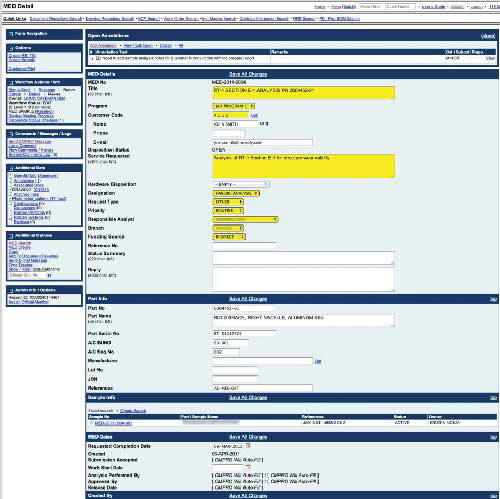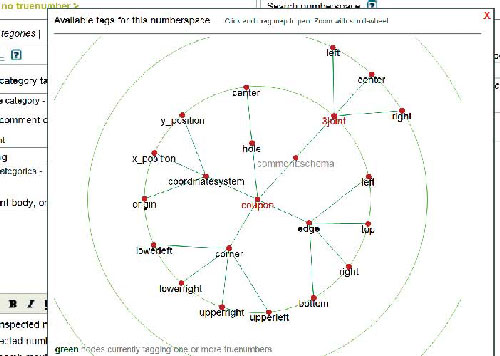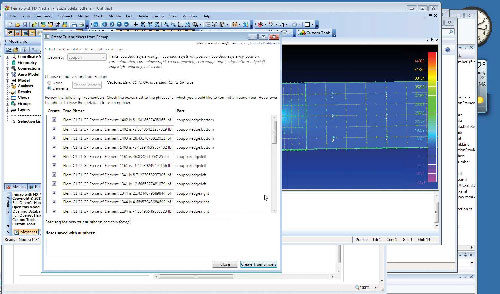April 1, 2012
By Kenneth Wong
Antique and art dealers often talk about an item’s provenance, its historical record. If someone is paying $140 million for a paint-dripped fiberboard titled Jackson Pollock’s No. 5, 1948 (which did happen at a private sale brokered by Sotheby’s), he would expect a paper trail proving subsequent ownership records, or expert authentication proving the item as Pollock’s masterpiece. But what about the tensile strength of an industrial material, the anticipated load specified in a simulation run, or the shear rate associated with a piece of metal?

With an interface to automatically export parameters and values to Femap analysis software, truenumbers users can simply select the desired region with a few mouse clicks.
Current product data management (PDM) and product lifecycle management (PLM) systems are quite good at giving you a history of engineering changes, material substitutions, and successes/failures in physical/digital tests. But the provenance of critical values and parameters employed in an engineering project is not usually the domain of PDM or PLM.
Why, for example, did someone choose to run a thermal simulation with 120°F as the threshold? Why did someone decide the new cockpit needs to withstand 600mph wind speeds? The answer is often buried in someone’s report, in an email from a safety specialist who recommended the parameter, or a white paper that outlines the industry standards.
A paint-spattered board is worth $140 million only if it is, in fact, the work of an abstract expressionist genius. By the same token, simulation results are reliable only if the parameters employed are trustworthy. Otherwise, it’s outright dangerous to make decisions based on them.
In many engineering projects, provenance of parameters still remains a black hole. To navigate this territory, you may need a new kind of PDM/PLM system—one that cares as much about history as it does about geometry.
truenumbers with True Histories
Allen Razdow, who invented Mathcad (now part of PTC’s software lineup), thinks you should be able to interrogate numbers. You don’t necessarily have to drag a suspicious number into a room and bombard it with questions under a bright light, in a good-cop-bad-cop routine. Rather, in Razdow’s vision, you should be able to just hover a mouse over a number to get its source, citation, reference and usage history. And if you happen to know about the reliability of a number (maybe you were once part of the academic research team that came up with that number), you can tag it and comment on it, just as you would with a Facebook picture where you recognize a familiar face. In doing so, you contribute to the growing provenance of the number.
Should you choose to reference this number in an email or a document, instead of just typing the digits, you may use a link. Such a number, called a truenumber in Razdow’s vocabulary, comes with its own history—a digital paper trail to tell you where it has been. Razdow’s company, True Engineering Technology, offers enterprise solutions based on the concept. Your company may deploy what True Engineering Technology calls Your Numberflow Server to store critical numbers and their histories.
When Razdow’s company launched the first commercial product in June 2011, the announcement read, “Engineers can use truenumbers to create an accurate record of any number which can be inserted into documents, used for calculations and shared with other engineers. And with the ability to verify the source of any truenumber from within a document or email, engineers will be able to know everything about a number all the time. truenumbers can be used in Word, Excel and PowerPoint documents, emails and HTML pages. truenumbers are also compatible with PTC’s Mathcad 15, ensuring that calculated numbers and their units stay intact outside of Mathcad.”
Floating Numbers in Simulation
When engineers at NAVAIR (short for Naval Air Systems Command) talk about a coupon, they’re not referring to a slip of paper that guarantees 20% discount at their naval base’s cafeteria. More likely, they’re talking about a set of values associated with a hotspot, an area on an aircraft they’ve singled out for close examination. A hotspot on the wingspan of an F-18 Hornet, for instance, comprises the loads and stresses that fall on the region, along with the parameters of its left and right edges.
To determine the loads and stresses, engineers at NAVAIR would model the coupon’s region, along with a proposed fastener, in Siemens PLM Software’s simulation package Femap. Using the loads and stresses obtained from Femap, they would then use StressCheck from Engineering Software and Research Development Inc. (ESRD) to simulate the coupon and obtain its stiffness and elasticity. Once these values were obtained, the authenticated values were imported back into the digital model of the aircraft.
Though adequate, the workflow required a fair amount of manual input when transferring values from one software to another—leaving room for possible errors. With True Engineering Technology’s Your Numberspace Dashboard application installed, however, NAVAIR engineers can tag the coupon’s geometry as truenumbers, making them easier to digitally store, search and locate.

CMPRO from Professional Systems Associates serves as the standard interface for NAVAIR employees to submit and retrieve engineering instructions.
The same approach was taken with material properties. A custom-developed Femap export tool lets engineers point and select the appropriate region and values directly on the 3D model. They could tag chosen values with appropriate metadata in a series of dialog boxes. When the coupon is sent to StressCheck for load and stress verification, the user simply picks the right coupon. Using intelligence embedded in the imported truenumbers, StressCheck automatically populates the input fields (through a harness developed using Truenumber SDK) with values associated with the selected coupon.
“With truenumbers, we will be able to manage and share critical data, including design parameters and materials properties, ensuring that anyone on the team can easily get the most up-to-date information available at any time, from anywhere,” says NAVAIR’s Ricardo Garcia, an early adopter of truenumbers. “When you are keeping a fleet of sophisticated military airplanes flying to support U.S. combat troops, confusion over a simple calculation that goes unchecked can have catastrophic results.”
Saving Numbers in Context
The standard interface at NAVAIR for submitting a request for engineering instructions is powered by CMPRO, a configuration management system from Professional Systems Associates (PSA). PSA describes itself as a PLM vendor, but because of its history of working with sectors within the U.S. Department of Defense, its solutions have become almost tailor-made for the DOD’s needs. Using CMPRO, an authorized person at NAVAIR might, for instance, submit a request to verify whether a certain sample has the required tensile bond strength, hardness and metallography.
Announcing the deployment of its technology, PSA wrote, “The Materials Engineering Database System (MEDS) module was written by PSA (the developers of CMPRO), and is now being utilized by Material Labs at various NAVAIR sites across the U.S. It first went into production at the Jacksonville Materials Laboratory and is installed on the CMPRO server riding in PAX River. The module is now being expanded throughout the other NAVAIR sites providing PLM functions (and other specialized functionality) to thousands of users on NAVAIR and contractor facilities across the globe.”
The depots where MEDS is deployed, according to Moe Parker, CEO of PSA, are sites responsible for performing detailed maintenance work on aircraft that goes beyond routine checkups.
“At these places, they just don’t do simple changes like oil and air filter,” Parker says. “They’ll strip ]aircraft] down to their metal rivets, identify issues, and engineer new solutions if needed.”

truenumbers from True Engineering Technology lets NAVAIR engineers create coupons (references to critical regions on aircrafts) by tagging appropriate values. The system makes it possible to automatically load coordinates and parameters associated with the referenced region when conducting simulation.
At sites where hundreds of aircraft are under analysis, where many different physical and digital tests occurring simultaneously, CMPRO’s single point of inquiry and reporting keeps the data traffic flowing efficiently.
“Over time, a plane will return for more service work,” explains Parker. “]The engineering staff] can then go look at the CMPRO archive for a record of the plane’s maintenance history. This allows the staff to retrieve an analysis that might have been performed two years ago and see the results: Was there a crack? What did the crack look like? What was the diagnosis? Did it say it should last 2,000 hours more? All these findings will be on record, along with the associated data ]from the analysis software used] for engineers to review.”
With an eye toward the increased use of mobile devices by field crews, PSA has begun supporting mobile devices. If an engineer is retrieving an analysis report from a mobile device, he or she may click on a link, with the option to view the results archived online in a mobile-friendly format (not a mobile app). For NAVAIR, consistent with strict security guidelines, CMPRO requires users to supply additional authentication before he or she is allowed to access the data, whether someone is accessing the data from a mobile device, laptop or desktop.
“A website is never going to be an ideal way to share analysis results,” Parker admits, “but engineers need a way to share that data with the rest of the organization. Promoting changes in how engineers interface with one another—that’s our specialty.”
Micro- vs. Macro-history
At the micro level, truenumbers provides NAVAIR with a way to nest history, intelligence and comments in the critical parameters used in projects, which makes data flow from one software to another smoothly. Certain manual routines, such as entering input fields in analysis systems, gets simpler as selected truenumbers can automatically query and load the associated data.
At the macro level, PSA’s CMPRO provides NAVAIR with the ability to retrieve and review the series of digital and physical tests performed on its aircraft. Because aircraft tend to outlive personnel changes and engineers’ assignments, a data management system with a single requisition interface and a consolidated view ensures crew members new and old are working with the same understanding of an aircraft’s maintenance history.
As engineering projects become more complex, and multi-tiered collaboration becomes standard practice, establishing data provenance and reviewing project history may become everyone’s responsibility.
Kenneth Wong is Desktop Engineering’s resident blogger and senior editor. Contact him via [email protected].
MORE INFO
Subscribe to our FREE magazine, FREE email newsletters or both!
About the Author
Kenneth Wong is Digital Engineering’s resident blogger and senior editor. Email him at [email protected] or share your thoughts on this article at digitaleng.news/facebook.
Follow DE





